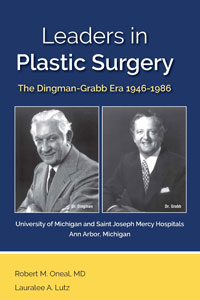
Leaders in Plastic Surgery
Skip other details (including permanent urls, DOI, citation information): This work is licensed under a Creative Commons Attribution-NonCommercial-NoDerivatives 3.0 License. Please contact [email protected] to use this work in a way not covered by the license.
For more information, read Michigan Publishing's access and usage policy.
Reed O. Dingman, MD, DDS (1906–85)
Dr. Reed O. Dingman grew up in Detroit, Michigan (Photo 3). He went to Southwestern High School and then graduated from Wayne State University. He received his AB degree from the UM in 1928 and his DDS degree from the UM Dental School in 1931. In 1932, he completed a master’s degree in oral surgery and became an assistant professor in the Department of Oral Surgery. In addition, in 1932, he enrolled in the UM Medical School, receiving his MD degree in 1936. From 1936 to 1937, Dr. Dingman completed a straight surgery internship at Barnes Hospital in St. Louis, Missouri, under Dr. Minot Fryer. After his internship, he was a resident in oral and maxillofacial surgery at the Geisinger Memorial Clinic in Danville, Pennsylvania, from 1937 to 1939. In 1940, he returned to Ann Arbor, accepted a position as assistant professor in the UM Dental School, and became an assistant to Dr. John Kemper. He also served as a preceptor in plastic surgery at the medical school.
In 1945, as he felt a need for more formal training, he enrolled as a resident in plastic surgery for one year under Dr. Ferris Smith at Blodgett Hospital in Grand Rapids, Michigan. David (Photo 4), Dr. Dingman’s son, related to me his recollection that it was during his father’s time in Grand Rapids in training with Dr. Smith that the accident occurred in which Dr. Smith was hit by a car and subsequently suffered very severe and disabling injuries. According to Dave, his father had to take over a lot of Dr. Smith’s practice in Grand Rapids even while he was still completing his training.[5] In 1946, Dr. Dingman returned to Ann Arbor, continuing as associate professor of oral surgery, and joined Dr. Kemper in a private plastic surgery practice at Saint Joseph Mercy Hospital (SJMH) in Ann Arbor (see Photo 5).
They both felt that there was a need for a formal plastic surgical training experience in Ann Arbor. In his own words, Dr. Dingman explained the origins of the original preceptorship at SJMH:
Following the end of the Second World War, many young men were seeking places in which to train and get experience in plastic and reconstructive surgery. Although there was no formal training program at the University of Michigan, Dr. Kemper and I in 1948 developed a preceptee program for a one- or two-year period to accommodate some of those who wished to come to Ann Arbor. Appointments were to SJMH in Ann Arbor, where we had private patients. Preceptees also worked in the Department of Oral Surgery at University Hospital. Dr. Joseph Ewing of Akron, Ohio, was one of the first to come to Ann Arbor on this basis. He remained for a year and was followed by Drs. Howard Billman, Clyde Litton (1948), Wilmer Hansen (1952), and Paul Natvig (1955). Although this was not an approved residency training program at the time, our trainees were given recognition as preceptees and permitted to sit for examination by the American Board of Plastic Surgery.[6]
Circumstances following Dr. Kemper’s sudden death in 1952 had a profound influence on the history of plastic surgery and its relationship with the UM Dental School. Dr. Dingman was invited to succeed Dr. Kemper as the chairman of the Department of Oral Surgery at the dental school, but he declined this offer and instead accepted a position as an assistant professor in the Department of Surgery at the Medical Center. This decision was thought to be the cause of some resentment over the years within the dental school, specifically within the oral surgery department. It seems Dr. Dingman had a vision that the best chance of ultimately forming a plastic surgery section had to come from within the Department of Surgery at the university by providing good patient care as well as education. He felt that Dr. Frederick Coller, chairman of the Department of Surgery (Photo 6), wanted plastic surgery exposure in the surgery department to enhance teaching for the general surgery residents.






